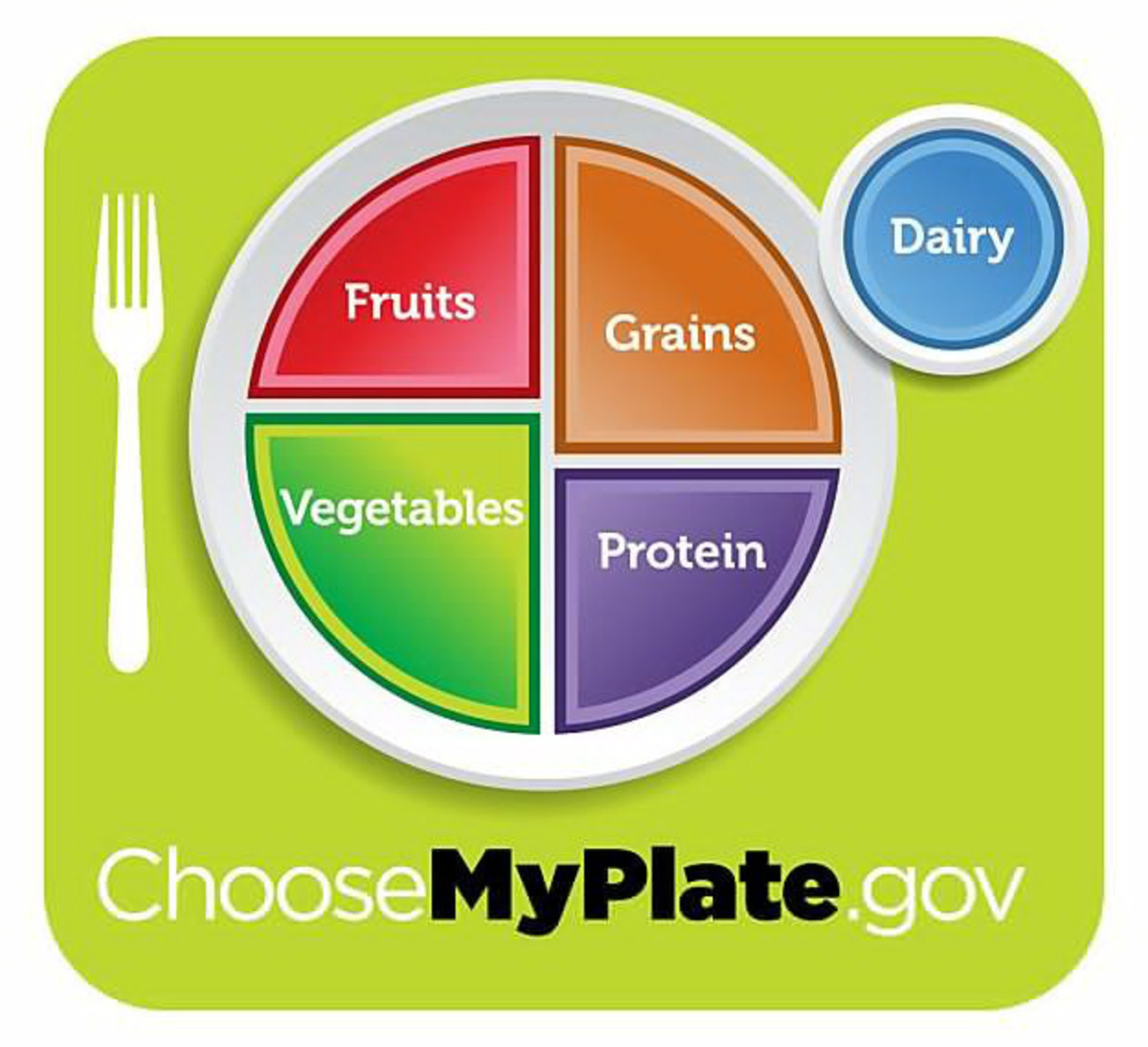Understanding Nutritional Labels Rules
I found there is a wealth of information that can be gleaned from nutrition fact labels. When analyzed properly, nutrition fact labels give you information that can help you make decisions about what you are trying to do with a diet. They can give you information on what types of nutrients and foods are good for you and which are bad for you. For example, it will show you which foods are a high source of fats and cholesterol, which are not good for you and which foods are a high source of dietary fiber which are good for you.
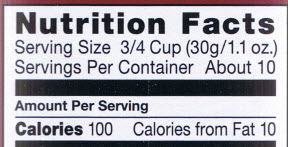
Serving Size
All nutrition fact labels are standardized by the FDA and they all start with the serving size of one serving. In this example, one serving is equal to 3/4 cup or 30 grams. The label shows there are about 10 servings per container. Therefore, there are about ten 3/4, cups in the total content of the container. The next time you eat cereal, try pouring out one serving so that you can see how much it really is.
The remaining information on the label is for one serving. The serving size is calculated by the FDA and is a measurement, not a recommendation.
Calories
This shows what a serving of food adds to your daily total calorie count. A person’s size and activity level helps determine total calories needed per day. For example, an active person needs about 2,500 calories each day. While an inactive person needs about 2,000 calories each day. Calories counts may vary based on gender and weight.
Fat Calories
These are the number of calories that are derived from fat. In this example there are 100 calories in one serving and only 10 of those calories are derived from fat. So 90% of the calories are not derived from fat.
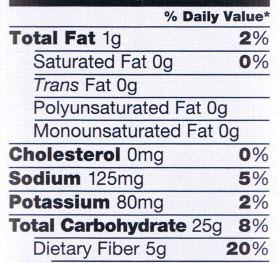
% Daily Value
These percentages are recommended by the U.S Department of Agriculture (USDA) and are based on a daily consumption of 2,000 calories a day. The percentages adjacent to each nutrient is a guide established by the FDA to help you make decisions about the intake of foods and nutrients.
5/20 Rule
The FDA has established the 5/20 rule that allows you to make decisions based on what you are trying to do with your diet. If you are trying to cut back on a certain nutrient, then you should look for food that has 5% or less of that nutrient. If you are trying to increase nutrients then you should look for foods that contain 20% or more of that nutrient. For example, if you are trying to reduce your sodium intake, then you should look for sources that have 5% or less for their daily value. If you are trying to increase your vitamin C, look for sources that have 20% or more of that daily value.
Total Fat
This shows the total fat calories in one serving. It then breaks it down into different types of fats Saturated fats and trans fats are not good for you because they raise the level of bad cholesterol. Using the 5/20 rule, there should be less than 5% of these fats in the food. You can see there is the Total Fat of 2% and 0% of saturated fat and trans fat. Polyunsaturated and monounsaturated fats are good for you. Using the 5/20 rule, look for foods that contain 20% or more of polyunsaturated and monounsaturated fats. Note: to make foods taste better, many low fat foods have added sugar.
Cholesterol
Cholesterol is found in the blood. Only animal products contain cholesterol and it can be found in meat, fish, eggs, and whole milk products. It is recommended that adults limit their daily intake to 300 milligrams per day. Too much cholesterol can elevate your blood cholesterol level, thereby raising your heart-disease risk.
Sodium
The recommended daily limit for an average adult is 2,400 milligrams. Too much sodium can cause high blood pressure. The USDA states a food is low in sodium if it contains no more than 140 milligrams. In our example, there is only 125 mg of sodium. Using the 5/20 rule, there is 5% sodium. Since you should limit your sodium intake to 5% or below, it's O.K.
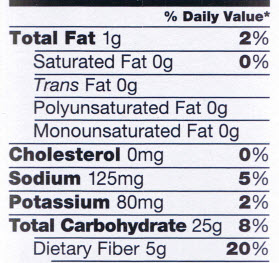
Total Carbohydrates
There are two types of carbohydrates: Simple and Complex. Simple carbohydrates require little digestion and thus are a quick energy source. Fruits, fruit juices and milk contain simple sugars (carbohydrates) that provide valuable nutrients in addition to an energy boost. However, food such as Candies, table sugar, alcoholic beverages and sweetened soft drinks are simple sugar sources that provide calories, but usually no nutrients.
Complex carbohydrates are found in grains, some vegetables and legumes. They are starches and metabolize slower than simple carbohydrates. Complex carbohydrates from grains are the body’s best source of energy because they are burned in a time-released manner. That's why athletes eat pasta before events. It's called carbohydrate loading and provides sustained energy. When eaten as part of a low-fat diet, the fiber found in complex carbohydrates like fruits and vegetables can help lower blood cholesterol in some people. Using the 5/20 rule for our example, there 25 grams of carbohydrates with 8% daily value. If you are trying to decrease carbohydrates, then 8% is 3% higher than what is recommended. If you are trying to increase carbohydrates, then 8% is 12% below the value needed.
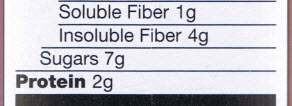
Dietary Fiber
The USDA recommends the average adult should eat between 21 and 35 grams of fiber daily, If you do reach that level, make sure you do take in plenty of fluids to prevent digestive bowel disorders. When buying bread or cereal, they should have 3 grams or more per serving. Some labels describe whether the fiber is soluble or insoluble.
Soluble fiber is absorbed during digestion, and can be found in oatmeal, barley, and dried beans. It can also help lower cholesterol levels. Insoluble fiber is not absorbed during digestion and can be found in whole grains, fruits and vegetable skins. Insoluble fiber protects against bowel disorders and may help aid digestion.
Sugars
Sugars are simple carbohydrates and include glucose, dextrose, fructose, all of which provide little nutritional value. Sugar shows up in surprising places, like crackers, "healthy" cereals, and salad dressings. It's often added to foods that need a flavor boost (like low-fat products).
In this example, there is only 7 grams of sugar per serving.
Protein
Protein can come from animal sources and also plant based sources. Animal sources include fish, milk, meat, and cheese. Plant source include beans, grains and cereals. Animal source protein is higher in saturated fat than plant source proteins. Study have shown that most adults get more protein than they need.

Vitamins and Minerals
This table is divided into two parts. The first part lists the percentage of vitamins and minerals contained in one serving of this cereal. The second part lists percentage of total daily grams of fat, cholesterol, sodium, potassium, carbohydrates, and fiber the FDA recommends in a 2,000- or 2,500-calorie diet. For example, the FDA recommends that for a 2,000 calorie per day diet, the total fat calories should be less than 65 grams and that total carbohydrates should be 300 grams.

Ingredients
Ingredients are listed in order of quantity. The ones with the highest quantity are listed first. In this example organic whole grain is listed first. Therefore it is the highest quantity ingredient and fruit concentrate is last as the lowest quantity ingredient.


